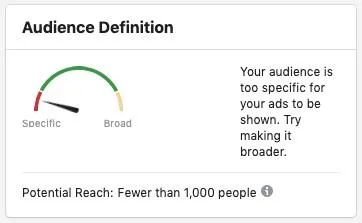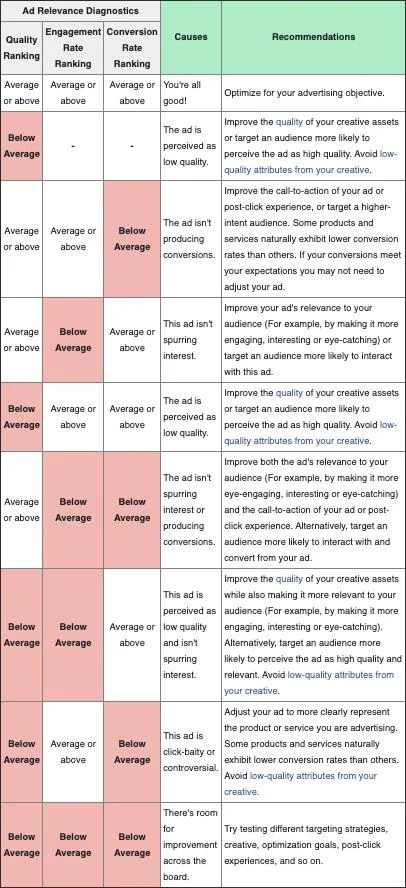Every marketer gets excited to see the performance they’re generating from their marketing campaigns. None of us set up ad campaigns without having some expectation of results.
So it’s understandably frustrating when you log in to see … nothing. Zeros across the board for your campaigns.
We always start off by checking the obvious: Did I turn it on? Am I on the right date range?
But what if those things are all set up properly? Then where do you turn?
Below are four common reasons your Facebook Ads aren’t delivering and how to fix each of these problems to get your ads back up and running. But, first, I’m going to go over one caveat.
Caveat: Not seeing your ad doesn’t mean it’s not showing
I’m sure I got your attention above by saying four reasons and one caveat, so I figured we should start with the caveat.
I feel it’s important to start off by saying this: There’s a difference between your ad not delivering and you or your client not seeing your ads.
So many marketers I talk to want to see their own ad, and I understand that. It’s almost a source of pride, and it is helpful to know, firsthand, that your ads are delivering.
But just because you’re not seeing your ads doesn’t mean they’re not delivering. Unlike Google Ads, Facebook ads are a bit harder to trigger impressions for yourself. On Google, you search the keywords you’re targeting and either the ad shows up or it doesn’t. Facebook isn’t nearly that easy.
Depending on the type of targeting you’re using, you can be nearly positive you should be seeing your ad or you could be completely in the dark as to whether you’re included in the target set or not, like in the case of a Lookalike Audience. So, for the remainder of this post, I’ll be focusing on when your ad isn’t gathering any impressions—not the use case where you personally aren’t seeing your ad.
Free guide >> 7 Fundamental Facebook Advertising Tips every advertiser should know.
Reason #1: Your audience is too small
In case you’ve been living under a rock, Facebook has had a few privacy concerns over the past few years. One way the company is working to keep things from being “too creepy” is to require advertisers to target a minimum audience size to run an ad campaign.
Your ads will not run on Facebook if you don’t have 1,000 active users in your target audience.
There are a number of ways this could be happening:
- The targeting parameters you’ve chosen simply don’t have enough users in them.
- You’re excluding nearly all of your audience in an effort to be efficient.
- Your customer upload list didn’t match as many people as you had hoped.
- Your targeting layers are set up incorrectly.
So, for those of you who are trying to be very, very targeted with your Facebook ads and reach only a select few people, this could be causing your ads to not show at all.
What to do about it
There are two courses of action here, and it comes down to one question: Can people outside of this special audience see your ads?
If it’s no, then you’re not going to be able to market to your select audience, as it’s not large enough.
If it’s yes, then your action item is to extend your audience in a way you feel confident. Maybe you need to add some additional behaviors or interests, maybe you should extend your demographic restrictions, or, if it’s a customer upload, you might simply need to add more users to the list. No matter what, you’ll have to reach an audience of 1,000 or more users to have your ad campaign run on Facebook.
Reason #2: Your ads are disapproved or limited
Facebook also has rules when it comes to the ads you can show on the platform that are similar to audience size guidelines.
There are restrictions around the amount of text you can have in an image. Each ad creative can only have 20% text in an image, otherwise its impressions will be limited or shut off completely. You can use this tool to check your ad creative before uploading.
Advertisers are also limited on advertising when it comes to special categories such as age, politics, housing, dating, etc. Each of these is a protected category and requires additional approval or restrictions to ensure there’s no discrimination occurring on the platform.
Conversely, in some rarer cases, your ad is being flagged for these violations but you’re not actually in breach. In an effort to be proactive, Facebook will sometimes automatically deny ads that are close to the line in the name of caution. If your ads are wrongly disapproved, you can reach out to support to get them approved again. It might take a good amount of time on the phone and some follow-ups, but for the most part, I’ve been able to get all inaccurate disapprovals overturned.
Check out our easy guide to Facebook approvals (and disapprovals!) here.
What to do about it
This one is pretty limited in your options. Either fix the ads to fit within Facebook’s parameters or your ads won’t show.
That might mean filling out the political paperwork, creating new images with less text, being on the phone with Facebook support for hours to get your ads approved (been there, done that), or something else. But without this approval, your ads will not show.
Reason #3: Your ad has very bad or low engagement
Facebook has a duty to its users to be sure the environment is engaging and entertaining. For ad campaigns, that means ads with little/no engagement or bad engagement don’t get shown as often as the ones that have lots of positive engagement.
There are three factors at play for all creative:
- Quality Ranking: A ranking of your ad’s perceived quality. Quality is measured using feedback on your ads and the post-click experience. Your ad is ranked against ads that competed for the same audience.
- Engagement Rate Ranking: A ranking of your ad’s expected engagement rate. Engagement includes all clicks, likes, comments, and shares. Your ad is ranked against ads that competed for the same audience.
- Conversion Rate Ranking: A ranking of your ad’s expected conversion rate. Your ad is ranked against ads with your optimization goal that competed for the same audience.
What to do about it
The first (and easiest) thing I usually suggest is to create a new ad and hope it gets better engagement.
If that doesn’t work and you’re having a hard time getting traction, try putting your ads into an engagement campaign, then leveraging those ads in a new campaign once they have good engagement built up.
If those aren’t working, there are other strategies you can employ based on the ad relevance diagnostics you’re seeing.
To be quite honest, there are so many potential combinations about how you should optimize your ads that I think it’s easier to show you in an image than in text. Here’s a guide Facebook put together:
If you want to read more on this, check out this article.
Reason #4: Your bid/budget parameters are too restrictive
One of Facebook’s greatest strengths is the algorithm that determines who sees your ads and who doesn’t. Even within a target audience, not all users will see your ad as Facebook is serving to those it thinks are most likely to reach the goal you’re optimizing for, whether it be a landing page view, lead gen form submission, online purchase, or ad engagement.
This decision-making process is made possible by some leniency to learn from performance, whether positive or negative. This learning process can be hampered if we advertisers are too restrictive with our budgets or our bid goals.
Here are a couple examples:
Let’s say we want to sell t-shirts for $20 each, but in an effort to be frugal, we only give Facebook a $1 daily budget and have it optimize for conversions. Unless you have the most amazing t-shirts that can sell themselves (this clearly isn’t the case, otherwise you wouldn’t be using Facebook), then this is a pretty unreasonable budget and goal combo. With a budget this small, Facebook can’t serve ads and learn fast enough to believe it will see any success and will likely stop serving your ads.
In the same vein, let’s say you have Facebook a reasonable budget of $20/day to learn, but instead set tight bid caps of $1. Similar to the budget, Facebook will likely have a hard time reaching the audience most likely to convert with only a max bid of $1. If it doesn’t see success, it will stop serving your ads simply because it can’t get any traction to learn and optimize.
What to do about it
Keep your budget and bid restrictions in line to give Facebook enough time to learn and optimize.
For budget, I try to give 50% of my target CPA as the daily budget. So for our t-shirt to break even, that would be a $10/day budget. This isn’t a hardline rule, but be sure you’re being reasonable with your level of investment. If you can’t spend that much, then maybe you should hold off on Facebook Ads or look to change the goal of your campaigns.
For bids, in my experience, it’s worked best for me to start off with automatic bidding for lowest cost and then adjust based on initial performance. I try to give the campaigns a week or two, sometimes a month if possible, to run before setting restrictions.
Facebook ads not delivering: Identify the problem & use these solutions!
There are a number of reasons your ad might not be delivering on the Facebook platform, but unless you’re simply going against all regulations, there’s no reason things have to stay that way.
Hopefully one of the situations above gives you some ideas of how to get your ads showing again and even generating sales on Facebook ASAP!







0 Comments